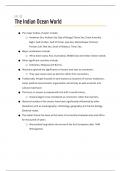GES 110
The Indian Ocean World
● The major bodies of water include:
○ Andaman Sea, Arabian Sea, Bay of Bengal, Flores Sea, Great Australia,
Bight, Gulf of Aden, Gulf of Oman, Java Sea, Mozambique Channel,
Persian Gulf, Red Sea, Strait of Malacca, Timor Sea.
● Major Landmasses include:
○ Africa (east coast), Asia, Australasia, Middle East and Indian Ocean islands.
● Other significant countries include:
○ Indonesia, Malaysia and Burma.
● Historians ignored the significance of oceans and seas as connectors.
○ They saw oceans seen as barriers rather than connectors.
● Traditionally, People focused on land masses as locations of human endeavour,
social, political and economic organisation and activity as well as artistic and
cultural expression.
● The focus on oceans increased with the shift in world history.
○ Oceans began to be considered as connectors rather than barriers.
● Historical studies of the oceans have been significantly influenced by other
disciplines such as oceanography, climatology, geography and marine biology
(External route).
● The Indian Ocean has been at the heart of connections between Asia and Africa
for thousands of years.
○ Was evident long before the arrival of the first Europeans after 1498
(Portuguese).
, Weather affects
● The Indian Ocean world is shaped by climate and environment.
○ The monsoon dictates the pattern of exchange in commodities, cultures,
people and ideas because it determines travel time.
○ The monsoon is a seasonal climate pattern between the ocean and
landmass.
○ For one half of the year the wind blows from the southwest and the other
half from the northeast – impacting travel in either direction.
○ This meant that travel in the Indian Ocean world was seasonal depending
on the monsoon winds.
● Seasonal travel also meant that all those who travelled the Indian Ocean needed
to stopover, which led to the growth of port cities and littoral (coastal) societies
and cultures.
● The climate and environment also dictated the kinds of commodities that came
to define the Indian Ocean world, in particular spices: cloves, nutmeg, mace
Prior to European Arrival
● The Indian Ocean was dominated by
○ Chinese, African, Indian and Muslim maritime trade.
● China, under the Song and Tang dynasties developed strong trade links with
other parts of Asia.
○ Strongly along the tributary rivers and waterways of the Indian Ocean.
○ These trade routes expanded under the Ming dynasty from the beginning
of the 1400s.




